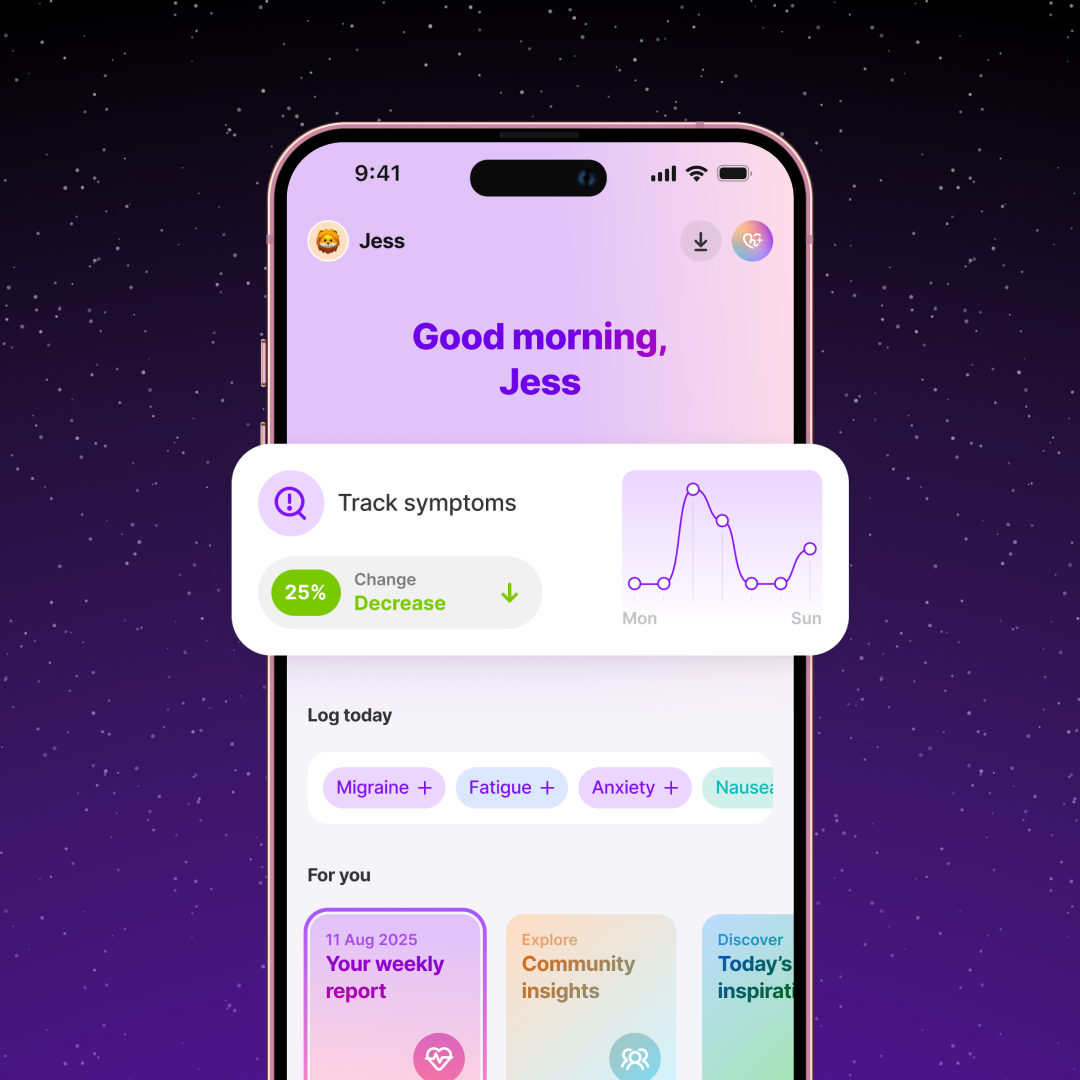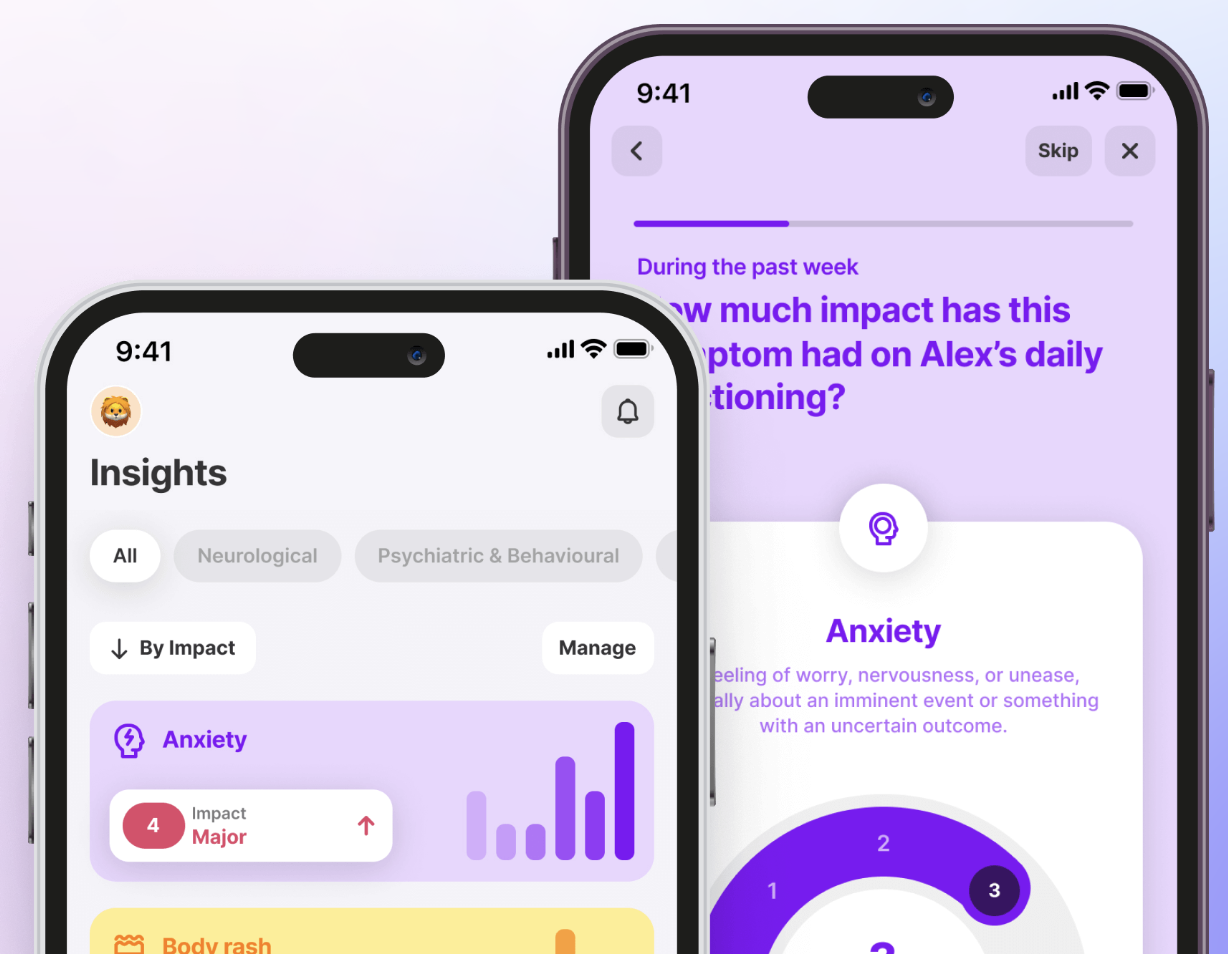Fibromyalgia and Autism: Overlapping Symptoms & How to Manage
October 1, 2025

- No clear link yet: There’s no proven cause-and-effect link, but the two conditions often share traits like sensory sensitivities.
- Shared symptoms happen: Fatigue, widespread pain, and sleep challenges can appear in both conditions, sometimes making it hard to tell them apart.
- A professional evaluation is essential: Only a qualified healthcare provider can determine whether symptoms relate to fibromyalgia, Autism, or both.
- Tracking can support your care: The Human Health app lets you log pain levels, sensory triggers, and sleep patterns, so you can share clear summaries with your provider.
Disclaimer: Human Health is a health-tracking platform and does not provide medical advice, diagnosis, or treatment. The information below is for general knowledge and is not a substitute for professional medical care. Always consult a qualified healthcare professional about any concerns regarding fibromyalgia, Autism, or overlapping symptoms.
Living with fibromyalgia or Autism can be challenging on its own. Coping with both, or trying to untangle where symptoms come from, can feel overwhelming. Researchers have not found a direct cause-and-effect link, but studies show overlap in both directions: Autistic people are more likely to experience chronic pain conditions such as fibromyalgia, and people with fibromyalgia often report higher levels of Autistic traits than the general population.
This article will explain what is known about the link between fibromyalgia and Autism, highlight key overlapping symptoms, and share practical ways to track and manage your health. The goal is to help you feel more informed and prepared to talk with your healthcare provider.
What may be the link between fibromyalgia and Autism?
There is no proven cause-and-effect link between fibromyalgia and Autism, but researchers are exploring why the two conditions so often share traits. Both involve changes in how the nervous system processes sensations, a pattern called central sensitisation. Studies suggest the overlap may run in both directions.
Autistic people appear more likely to experience chronic pain conditions such as fibromyalgia, while people with fibromyalgia often report higher levels of Autistic traits than the general population. For example, a 2024 clinical study of Autistic youth found that more than half experienced widespread pain, highlighting the high rate of chronic pain in Autism.
Research shows that Autistic people often experience differences in how they process sensations and respond to pain. Some may be more sensitive, while others may react in unexpected ways. Scientists are still piecing together exactly why this happens, so the full picture remains incomplete.
Fibromyalgia and Autism: Possible overlap of symptoms
Symptoms like pain, fatigue, and sensory sensitivity can show up in both fibromyalgia and Autism. This can create a blurred picture of what’s driving certain challenges, which is why careful tracking and clinical input are so important.
Widespread pain and tenderness
Both fibromyalgia and Autism-associated central sensitivity can involve persistent pain or tenderness across the body.
Fibromyalgia often shows up as diffuse muscle pain or even episodes of fibromyalgia numbness, while Autistic individuals may describe pain linked to sensory overload or tension.
You can learn more about Fibromyalgia rib and chest pain to understand how this condition contributes to overall muscle tenderness and discomfort.
Fatigue and low energy
Chronic fatigue is common in both conditions, sometimes worsened by pain disrupting sleep or the mental effort of managing sensory input. Some individuals also report concerns such as weight gain in fibromyalgia, which may stem from limited activity, hormonal changes, or medication side effects.

Sensory sensitivities
Heightened reactions to stimuli (e.g., sound, touch) are common in Autism, and fibromyalgia patients also show hypersensitivity to non-painful stimuli such as sound.
Sleep difficulties
Sleep problems, such as difficulty falling or staying asleep, have been reported in both fibromyalgia and Autism. Research also notes that in Autism, sleep issues may interact with pain and other challenges (Bogdanova et al. 2022).
How stress affects symptoms
Stress and anxiety often amplify pain in fibromyalgia, and in Autism may trigger meltdowns or shutdowns; together, these dynamics can produce cycles of increased discomfort.
Overlapping vs. unique symptoms
Here’s a quick snapshot of how certain symptoms tend to show up in fibromyalgia, Autism, or both. This can help highlight where the experiences overlap and where they remain distinct. For instance, some individuals may also experience symptoms like fibromyalgia nausea, which can further complicate daily life and make symptom tracking even more essential.
Use the Human Health app to track pain levels, sleep patterns, sensory triggers, and stress events. The app can generate a PDF summary to share with your healthcare provider, helping them see patterns across both conditions.
How to know if it’s fibromyalgia or Autism?
Telling fibromyalgia and Autism apart isn’t always straightforward. Symptoms like fatigue, pain, and sleep problems can look similar, but only a qualified healthcare professional can sort out the cause and give you a clear assessment. If you’re also curious about how fibromyalgia compares with other neurological conditions, you can read more about fibromyalgia vs MS for additional insights.
You can also learn more about the connection between Fibromyalgia and Neuropathy to understand how these two conditions may overlap in symptoms and nerve pain.
Can it be both?
Yes, it’s possible to have both. Fibromyalgia is a chronic pain condition, while Autism is a neurodevelopmental difference, so they can exist side by side. People living with both often benefit from a team approach to care that supports pain management, sensory needs, and mental health.
When to see a doctor
Reach out to your primary care doctor or specialist if your pain, fatigue, or sensory sensitivities significantly affect daily life, or if symptoms are new or worsening. A professional can rule out other causes, recommend appropriate testing, and guide next steps.
{{inline-cta-1}}
Daily strategies for living with both
Living with both conditions can feel overwhelming, but focusing on small, steady routines may help you feel more supported and in control. These steps are not treatments; they are practical ways to work with your healthcare provider and support your well-being day to day.
Gentle daily movement may help
Short walks, stretching, or water-based activities may ease stiffness and lift mood without putting too much strain on your body. Always check with your healthcare provider before changing your routine.
{{pro-tip-1}}
Build consistent sleep routines
Going to bed and waking up at the same time each day can help your body find rhythm. Creating a calm, sensory-friendly environment, such as dim lights, quiet sounds, or a weighted blanket, may support more restful sleep.
{{pro-tip-2}}
Identify and reduce triggers
Track patterns of pain flares, sensory overload, or stress responses. Understanding what contributes to a fibromyalgia flare up can help you pinpoint triggers such as temperature changes, overstimulating environments, or disrupted routines.
Support emotional well-being
Consider using stress-management techniques such as breathing exercises, mindfulness, or working with a therapist knowledgeable in neurodiverse care. Reducing stress may help prevent symptom flare-ups.
With the Human Health app, you can log pain scores, sleep quality, mood changes, and sensory triggers in one place. Over time, these records may highlight trends you can share with your healthcare provider to guide more personalized care.

How the Human Health app can help you manage fibromyalgia & Autism
Keeping track of pain levels, sleep quality, sensory triggers, and mood changes can feel overwhelming when you’re managing two conditions at once. The Human Health app helps by allowing you to:
- Log symptoms daily, from pain and fatigue to sensory sensitivities
- Track treatments or routines that seem to help you cope
- Generate a PDF summary to share with your healthcare provider for more focused appointments
- Organize information in one secure place, reducing stress and improving communication with your care team
Start today: Log your top two or three symptoms this week and bring the summary to your next visit. You’ll have a clearer picture of your health and a stronger voice in your care.
Disclaimer: Human Health is a health-tracking platform and does not provide medical advice, diagnosis, or treatment. The information below is for general knowledge and is not a substitute for professional medical care. Always consult a qualified healthcare professional about any health concerns.
References
- National Library of Medicine: Central Sensitivity Symptoms and Autistic Traits in Autistic and Non‐Autistic Adults
- University of Plymouth: Autistic Traits in Fibromyalgia are Associated with Hypersensitivity and Central Sensitisation
- BMC: Autism and chronic ill health: an observational study of symptoms and diagnoses of central sensitivity syndromes in autistic adults
- MDPI: Chronic Pain in Autistic Youth: Clinical Prevalence and Reflections on Tailoring Evidence-Based Interventions from an Interdisciplinary Treatment Team
- National Library of Medicine: The Current View on the Paradox of Pain in Autism Spectrum Disorders
- National Library of Medicine: Associations between autistic and comorbid somatic problems of gastrointestinal disorders, food allergy, pain, and fatigue in adults
- ScienceDirect: Fibromyalgia Patients Are Not Only Hypersensitive to Painful Stimuli But Also to Acoustic Stimuli
- Frontiers in Psychiatry: The Current View on the Paradox of Pain in Autism Spectrum Disorders
- National Library of Medicine: Exercise Therapy for Fibromyalgia
- Frontiers in Psychology: Effects of Mindfulness Training on Sleep Problems in Patients With Fibromyalgia
- MDPI: Stress Management as a Clinical Approach to the Complementary Treatment of Fibromyalgia
- National Library of Medicine: The relationship between Autism spectrum disorder and sleep
This is a div block with a Webflow interaction that will be triggered when the heading is in the view.


Manage Fibromyalgia & Autism Inside Our App!
Managing your condition doesn't have to be hard, or messy. Our app helps you centralize everything and allows you to track everything.







Pro tip
Pair gentle activity with something enjoyable, like a podcast or calming music, so it feels like a positive part of your day rather than another task.
Pro tip
Use the Human Health app to log your sleep quality each morning. Over time, these self-reports may reveal links between poor rest and symptom flare-ups that you and your healthcare provider can address together.

.jpg)




.png)

